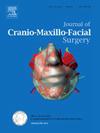Feasibility analysis of the iliac tubercle in repairing maxillary canine region defects
IF 2.1
2区 医学
Q2 DENTISTRY, ORAL SURGERY & MEDICINE
引用次数: 0
Abstract
The maxilla is the key structure in the midface. Although literature suggests that the iliac crest has natural curvature closely resembles that of the maxilla, the theoretical and anatomical evidence supporting this similarity remains limited. In our study, we evaluated and compared the morphological characteristics of the maxillary canine region and the iliac tubercle. Sixty-seven patients who underwent 3D CT reconstruction of the head and iliac regions were included. The patients were grouped by sex (male and female) and site (left and right). The thickness, length, and curvature of the maxillary canine region and iliac tubercle were measured and compared, and the findings were validated through surgical practice. The iliac tubercle demonstrated a close match with the maxillary canine region in terms of curvature, with no significant differences observed. Although the iliac tubercle was significantly thicker than the maxillary canine region (P < 0.001), it could be adjusted to the required dimensions through bone grinding. For unilateral maxillary canine region defects, reconstruction can be achieved using either the ipsilateral anterior portion or the contralateral posterior portion of the iliac crest. In conclusion, the iliac tubercle provides sufficient bone volume and anatomical compatibility for maxillary reconstruction, which offers a reliable option for restoring both function and aesthetics in patients with maxillary canine region defects.
髂结节修复上颌犬齿区缺损的可行性分析。
上颌骨是面部中部的关键结构。虽然文献表明髂嵴的自然曲率与上颌骨非常相似,但支持这种相似性的理论和解剖学证据仍然有限。在我们的研究中,我们评估和比较上颌犬齿区和髂结节的形态特征。67例患者接受了头部和髂区的三维CT重建。患者按性别(男、女)和部位(左、右)分组。测量和比较上颌犬齿区和髂结节的厚度、长度和曲率,并通过手术实践验证结果。髂结节表现出与上颌犬齿区域在曲率方面的密切匹配,没有观察到显著差异。虽然髂结节明显比上颌犬齿区厚(P
本文章由计算机程序翻译,如有差异,请以英文原文为准。
求助全文
约1分钟内获得全文
求助全文
来源期刊
CiteScore
5.20
自引率
22.60%
发文量
117
审稿时长
70 days
期刊介绍:
The Journal of Cranio-Maxillofacial Surgery publishes articles covering all aspects of surgery of the head, face and jaw. Specific topics covered recently have included:
• Distraction osteogenesis
• Synthetic bone substitutes
• Fibroblast growth factors
• Fetal wound healing
• Skull base surgery
• Computer-assisted surgery
• Vascularized bone grafts

 求助内容:
求助内容: 应助结果提醒方式:
应助结果提醒方式:


